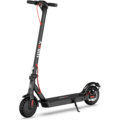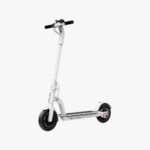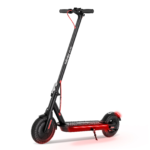- Home
- Scooters
- Electric Scooters
- Hiboy VE1 Pro
Hiboy VE1 Pro
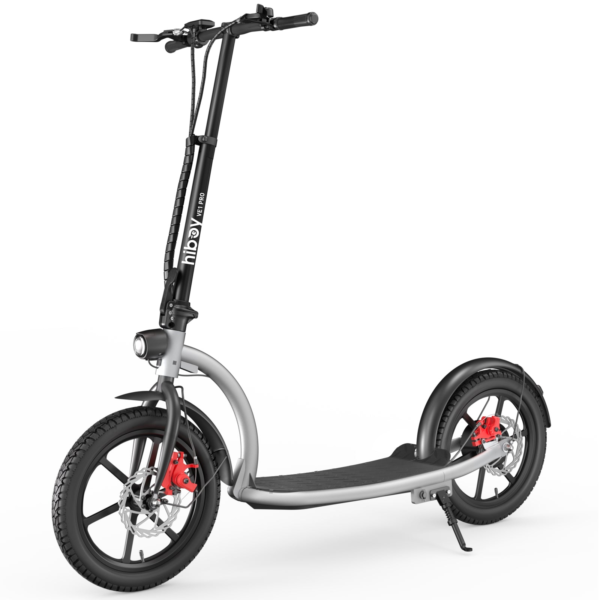

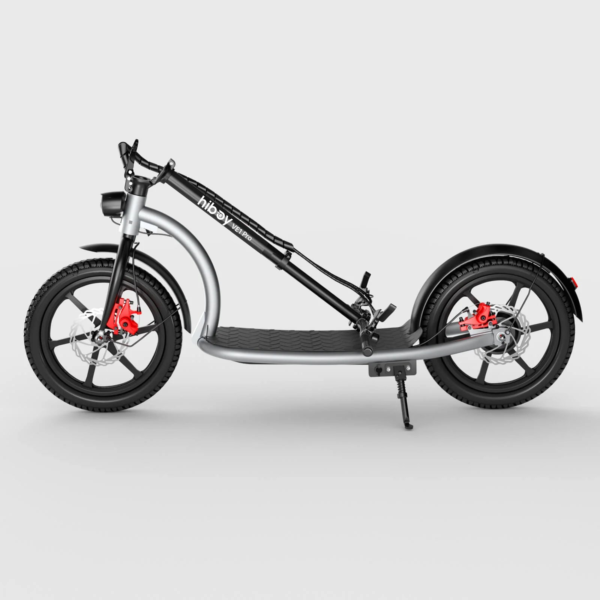
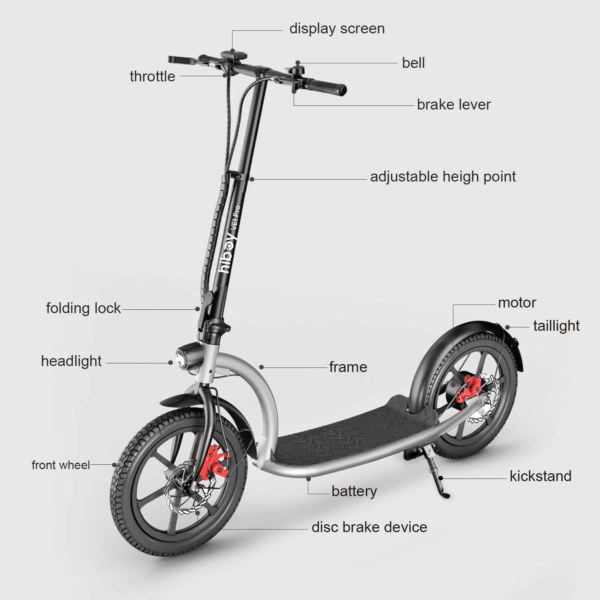
- Battery Range: 31 mi (50 km)
- Top Speed: 23 mph (37 km/h)
- Motor Power: 500 W nominal
- Weight Capacity: 265 lb (120 kg)
- Charging Time: ~6 h
- Scooter Weight: 62.0 lb (28.1 kg)
PROS
- Seated comfort for longer rides
- Large-diameter pneumatic tires
- Predictable braking with e-assist
- Stable chassis at city speeds
- Good visibility and lighting
CONS
- Heavier than stand-up commuters
- Needs more storage space folded
- Pneumatics require pressure care
- Overkill for very short trips

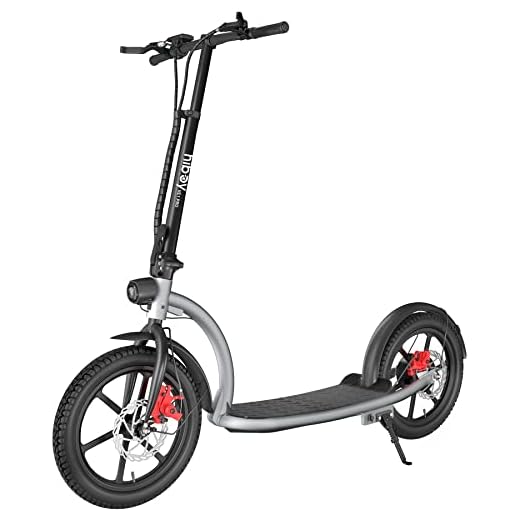
Hiboy VE1 Pro — A Comprehensive, Easy-to-Read Overview
Introduction: Why the VE1 Pro Stands Out
The Hiboy VE1 Pro is built for riders who want everyday practicality with a calmer, more confident ride than they’ll find on many compact scooters. It’s not chasing top-speed records or extreme sport vibes. Instead, it focuses on stability, comfort, and predictable performance—exactly what makes a commuter or recreational scooter feel stress-free on real streets. If you’re the kind of rider who values big, bump-softening tires, a roomy platform, and straightforward controls over flashy extras, the VE1 Pro aims squarely at you.
In busy city corridors and spread-out suburbs alike, consistent traction and a relaxed stance are what keep you rolling. That’s the VE1 Pro’s core promise: a scooter that feels planted, easy to balance, and forgiving over rough patches. Moreover, its feature mix leans into everyday convenience—fast to learn, simple to fold, and supported by widely available parts. When you’re looking for a no-drama ride that still has enough power and range to cover real miles, this model deserves a close look.
Before diving into deeper guidance about ride feel, commute use cases, and ownership tips, here’s a quick snapshot of the essentials that shape the VE1 Pro’s character: large 16-inch pneumatic tires, a 48-volt battery system, practical commuting speed, and an approachable weight for a big-wheel design. Those ingredients set the tone for everything you’ll read below—comfort first, confidence always, and enough punch for the daily grind.
Who the VE1 Pro Is Best For
Urban commuters who value stability. Big wheels and air-filled tires offer a noticeable comfort advantage on cracked asphalt, gravelly shoulders, and brick-lined streets. If your city mixes smooth bike lanes with sudden patches of rough pavement, you’ll appreciate the way this scooter absorbs chatter and keeps its line.
New riders and returning riders. If you’re newer to scooters, the VE1 Pro’s easy balance and predictable controls reduce the learning curve. If you’re coming back after a break, the stable stance can rebuild confidence quickly.
Suburban and campus riders. On campuses or in residential neighborhoods with speed humps and tree-root heaves, the compliant tires make casual rolling feel effortless. Longer sidewalks and multi-use paths are where this scooter settles into an easy rhythm.
Practical riders with moderate hills. While the VE1 Pro isn’t designed as a hill-climbing monster, it handles gentle to moderate grades respectably for a commuter. For steeper terrain day after day, you’ll still want to manage expectations around speed and battery draw.
Riders who want real spare-parts support. Replacement accessories—tubes, tires, chargers, and more—are widely available, which matters if you plan to own the scooter for multiple seasons and maintain it yourself.
Big-Wheel Comfort: What 16-Inch Pneumatic Tires Do for You
Wheel size shapes ride feel more than almost any other component. With 16-inch pneumatic tires, the VE1 Pro has a ride character closer to a small city bike than to a typical compact scooter. That means:
- Improved rollover: Bigger wheels bridge gaps and roll over small obstacles more easily. Expansion joints, shallow potholes, and uneven seams feel less dramatic.
- Better line-holding: At cruising speed, larger wheels track straighter with fewer twitchy corrections, which helps on long bike-lane stretches.
- More traction on imperfect surfaces: Air-filled tires flex to maintain contact across rough patches, offering a touch more grip when the road gets messy.
- Lower rider fatigue: Because buzzing vibration is damped at the tire, your feet, knees, and wrists don’t absorb as much sting over time.
Owners often remark how “bigger than expected” the VE1 Pro looks in person and how that translates to a calmer, more bicycle-like experience. If you’ve tried smaller-wheel scooters and found them nervous at speed, the step up in wheel size can feel transformative.
Everyday Performance: Speed, Modes, and Real-World Range
On paper, the VE1 Pro’s performance numbers position it as a strong commuter with headroom for weekend rides. In practice, what matters is how those numbers feel in your routine.
- Speed & control: The scooter’s commuter-class top speed is brisk enough to keep pace with urban cycling traffic without feeling excessive. With multiple ride modes, you can tailor acceleration and top-end to the environment—slow it down for dense foot traffic and open it up for empty bike lanes. Mode switching is quick and intuitive, so you can adapt mid-ride as conditions change.
- Power delivery: A nominal mid-class motor helps the scooter get up to speed confidently on flats, with sensible torque for gentle rises. Expect steeper hills to cut speed, especially if you’re near the max load or riding into wind.
- Range expectations: A 48V battery around 10Ah is a practical sweet spot for daily commuting. Claimed range figures are generous; real-world range depends on rider weight, temperature, hills, stop-and-go patterns, and tire pressure. Plan on a comfortable buffer; for many riders, that means treating the scooter like a 15–22 mile no-worry machine at mixed speeds.
- Charging rhythm: A roughly 5–6 hour charge time fits naturally into a “plug in after work” or “overnight top-off” routine. If you ride many miles daily, consider a second charger at the office to keep your battery in the middle of its state-of-charge window, which can be gentler on cells over the long term.
Pro tip: Keep tire pressure in the recommended range. Under-inflated big tires sap range and feel squirmy. Over-inflated tires ride harshly and lose grip on choppy surfaces. A simple floor pump with a gauge is one of the best investments you can make.
Ride Feel: Stable, Predictable, and Relaxed
The VE1 Pro’s personality is calm. It’s not the quickest scooter off the line, and it doesn’t need to be. Its large pneumatic tires and steady geometry encourage a relaxed stance that reduces micro-corrections at the handlebar. That calmer platform does several helpful things at once:
- Encourages a natural riding posture. With less nervous steering, your upper body can stay loose and your shoulders can relax.
- Smooths out rough corridors. The combination of wheel size and tire compliance keeps traction more consistent across cracks, pavers, and patched asphalt.
- Boosts confidence at speed. When the frame and wheels feel composed, your attention can return to traffic dynamics, signaling, and path choice rather than constantly tensing for jolts.
This isn’t just about comfort for comfort’s sake. Reduced fatigue equals better attention, which is a safety win—especially on the ride home when you’re tired from a long day.
Design and Build: A Practical Commuter Frame
The VE1 Pro’s design doesn’t scream for attention; it’s restrained on purpose. That’s a virtue. A low-key scooter blends in around office buildings and on transit, and it tends to age better cosmetically.
- Wide platform: A generous standing area gives your feet room to adjust, which makes longer rides feel less cramped. Alternating your stance slightly during a ride helps circulation and comfort.
- Straightforward folding: While any big-wheel scooter will be bulkier than a compact, the VE1 Pro’s folding system aims for quick collapses for trunk transport or tight indoor storage. Practice the fold at home once or twice; familiarity keeps fingers and cables safe.
- Weight balance: Around the high-40-pound range is a middle ground for a large-wheel commuter—portable enough for short stair carries, substantial enough to feel planted at speed. Plan your storage strategy accordingly (ground floor, elevator, or trunk rather than frequent long stair climbs).
- Weather-ready details: Typical splash resistance on commuters of this class means it’s built to handle puddle spray and light drizzle. As with any e-scooter, avoid deep standing water, and dry the scooter after wet rides to protect connectors and bearings.
Safety and Control: Braking, Lighting, and Visibility
A calm scooter still needs decisive stopping power and clear signaling. While specific brake hardware can vary by batch or region, the VE1 Pro approach is consistent: simple, serviceable components and bright lighting.
- Braking feel: Expect familiar, bicycle-style lever actuation and predictable modulation. Practice emergency stops in a safe area when you first get the scooter; learn how weight shift improves stopping distance and keeps the rear end planted.
- Lighting package: Front and rear lights increase your conspicuity, but you’re still small and quiet in traffic. Add active visibility with a reflective vest or helmet decals. Angle the headlight to light the path without blinding oncoming riders.
- Tires as safety components: With big, air-filled tires, you can justify checking pressures more often—weekly for frequent riders, bi-weekly otherwise. Proper inflation is safety-critical for grip, braking, and avoiding pinch flats.
Portability and Storage: Living With a Big-Wheel Scooter
If you’re coming from a 10-inch-wheel commuter, you’ll notice the VE1 Pro occupies more physical space. That said, planning your storage and transport makes ownership simple.
- Apartment living: Store near an outlet and away from radiators or heaters. A small rubber mat keeps your floor clean and catches drips after wet rides.
- Office parking: Ask about a low-traffic corner or a storage room. If that’s not possible, fold the scooter and lean it neatly under a desk or against a wall with a frame pad to prevent scuffs.
- Car trunk transport: Most hatchbacks and SUVs will swallow a folded big-wheel scooter easily. For sedans, fold the rear seats if needed. A blanket keeps upholstery safe from pedal scratches and dusty tires.
- Public transit: Check weight and size rules for buses or trains on your route. Off-peak rides are better for everyone, and a simple strap can keep the folded scooter from unfolding while you’re boarding.
Comfort and Ergonomics: Make It Yours
Comfort is personal. Fortunately, the VE1 Pro’s fundamentals make fine-tuning easy.
- Foot placement: On longer rides, change your front-foot angle or swap lead feet for a minute to refresh your stance. The wide deck gives you options.
- Handlebar height and wrist angle: Keep elbows slightly bent. If you feel wrist pressure, re-check bar rotation and lever angles. Small tweaks reduce numbness over time.
- Gloves and shoes: Lightweight cycling gloves clean up road buzz, and flat-soled shoes with a bit of cushioning pair perfectly with the pliant tires.
- Seasonal gear: In colder months, windproof gloves and a breathable shell keep you warm without bulk. In rainy seasons, a compact fender extension or clip-on mudguard can help with spray control.
Range in the Real World: How to Plan Your Trips
Numbers on a box are a starting point, not a promise. To get predictable range:
- Ride in a steady speed band. Avoid frequent full-throttle sprints if you need maximum miles per charge.
- Manage hills smartly. On long climbs, knock the mode down a notch and let speed fall slightly. You’ll reduce heat and current draw.
- Watch your tires. Under-inflation quietly steals miles; check pressures before longer rides.
- Pack light. Spare tubes and a small tool roll are smart; heavy backpacks are not.
- Charge rhythmically. Top up at home or work when convenient rather than deep-cycling the pack every single time. Aim to finish charging close to departure when possible.
With these habits, many riders find their reliable range lands well below the best-case claim, but with much less stress day to day. That predictable buffer is what turns a scooter into a real transportation tool.
Maintenance Made Simple: Keep It Rolling
The VE1 Pro is friendly to owner maintenance. Build a basic routine and you’ll prevent most headaches.
- Weekly (or every ~50–80 km):
- Check tire pressure and look for embedded debris.
- Quick wipe-down to spot loose screws, cable rub, or bent reflectors.
- Test lights and the bell or horn.
- Monthly:
- Inspect brake pads for wear and make minor cable or caliper adjustments if needed.
- Check deck bolts, stem clamp, and axle nuts for snugness (never overtighten; use sensible hand torque).
- Spin wheels and listen for gritty bearings.
- Seasonally:
- Deep clean, degrease brake rotors if present, and lightly lube pivot points—not brake surfaces.
- Inspect tires for sidewall cracks; replace tubes or tires if they’re aging or puncture-prone.
- Evaluate battery health by tracking how many miles you get per “bar” across similar rides.
Replacement parts like tubes, tires, chargers, and even control cables are commonly available, which minimizes downtime and supports multi-year ownership. Keep a spare tube and tire levers at home so a flat doesn’t sideline you for a week.
Weather and Surface Considerations
Light rain: Large pneumatic tires maintain better contact than solid tires on wet surfaces, but paint stripes, metal plates, and wet leaves are still slick. Brake earlier than usual and avoid abrupt lean angles. Splash resistance helps for puddle spray, though you should always avoid standing water that could submerge hubs or connectors. Dry the scooter after wet rides.
Heat: Hot days reduce air density and can feel great to ride, but they also accelerate battery and tire wear if you push hard at low pressures. Start with proper inflation; check mid-day if the scooter bakes in the sun.
Cold: Battery chemistry is less efficient at low temperatures. Expect a meaningful range drop in winter. Dress warmly, keep speeds smooth, and consider charging indoors at room temperature before departure.
Gravel and patchy paths: The big wheels really help here. Still, treat gravel like a caution zone—stay upright, avoid sudden throttle or brake spikes, and let the tires roll through with light hands.
Security and Charging Habits
- Locks: A sturdy lock through the frame or a heavy chain around a fixed object is a minimum for urban stops. Don’t forget the wheels—accessible bolts can be targets.
- Indoors vs outdoors: Whenever possible, store and charge indoors. Temperature swings and moisture shorten component life.
- Charger management: Use the correct charger, protect the cable ends from stress, and keep vents clear while charging. A simple timer plug can help avoid unnecessarily long “float” times once full.
The Ownership Experience: What It’s Like After Month One
After your first few weeks, most of the friction disappears. Your wrists and knees will appreciate the calmer ride; your mental workload at speed drops because the scooter isn’t buzzing or darting. You’ll learn your neighborhood’s best lines, the places where bike lanes stay clean, and the shortcuts that fit a scooter’s footprint better than a car’s. You’ll also establish your personal rhythm—how often to charge, when to switch modes, and which bag carries your lock without flopping around.
Many riders find that the VE1 Pro’s combination of big-wheel composure and unfussy controls makes it the scooter they keep reaching for even when they own something sportier or smaller. It’s the reliable daily driver—the one that clocks steady miles and needs only modest attention to keep performing.
Practical Setup Checklist (Do This on Day One)
- Unbox carefully and save packing materials in case you ever need to ship the scooter for service.
- Torque-check critical fasteners: stem clamp, handlebar bolts, axle nuts, and brake hardware.
- Inflate tires to the recommended PSI for your weight and road conditions. Re-check after your first few miles.
- Adjust brake levers for a natural wrist angle; set lever reach so you can comfortably brake with one or two fingers.
- Set display units & ride modes to your preference, then do a short shakedown ride in a safe area.
- Charge to full before your first real commute; note the charge time and how the indicator behaves.
- Record serial number and store receipts. Photograph the scooter for insurance.
- Plan your lock strategy before your first café stop—practice locking at home.
- Create a maintenance reminder on your phone for monthly checks.
- Carry a mini kit: multi-tool, tire levers, spare tube, small pump or CO₂ inflator, and wipes.
Common Questions, Answered
How does it feel compared with a typical 10-inch-wheel scooter?
More composed and less jittery. The VE1 Pro’s 16-inch pneumatic tires add rollover ability and calm steering, so the ride feels closer to a small city bike than a compact scooter.
Is it “too big” for apartment living?
It’s bigger than a compact commuter, but still manageable. If you have an elevator or ground-floor storage, day-to-day life is easy. For frequent stair carries, plan your route and consider a handle strap.
What range should I plan around?
Treat the best-case claims as just that—best case under ideal conditions. Most mixed urban riders should plan for a comfortable window well below that, then build in a personal buffer.
Can it handle rain?
It’s splash-resistant, not submersible. Light rain and wet streets are fine with extra caution, but avoid deep puddles. Dry the scooter after rides and store it indoors.
Are replacement parts available?
Yes—tubes, tires, chargers, and more are commonly stocked by multiple sellers, which is great for minimizing downtime and extending the scooter’s life.
Who shouldn’t pick the VE1 Pro?
If you need intense hill performance, ultra-light portability, or top-tier speed, this isn’t the best fit. Instead, choose a lighter city scooter for frequent carries or a higher-power model for extremely steep terrain.
Riding Scenarios: How the VE1 Pro Handles Different Days
The smooth-lane commute (5–7 miles each way):
Choose a mid ride mode, settle at a steady pace that matches cyclists, and enjoy a quiet, low-effort cruise. You’ll arrive fresh and unruffled, with plenty of battery left for errands.
The mixed-surface weekend loop:
Bike trails, neighborhood roads, and park connectors are the VE1 Pro’s happy place. The big tires shrug off random surface changes. Bring your tool roll, keep speeds respectful around other users, and savor the breeze.
The “messy Monday” with construction detours:
When your route throws gravel or poor temporary patches at you, the scooter’s wheel size keeps you poised. Roll through at an even throttle, avoid hard brake stabs, and read the terrain two steps ahead.
The grocery dash:
Load a small backpack rather than hanging weight from the bars. If your shop is close, consider a lower mode to keep throttle smooth and leave more range for the rest of the week.
Battery Care for Long Life
Lithium-ion packs prefer moderation. To reduce stress:
- Avoid storing the scooter fully charged for long periods; aim for around 50–70% if you’ll leave it unused for more than a week.
- Don’t deep-drain the pack regularly. If you arrive home with very low battery, charge soon.
- Keep it cool and dry. Heat is the enemy of long-term capacity.
- If your routine allows, do partial top-offs rather than always charging to 100% hours before you ride.
A gentle routine pays dividends by preserving range and power output over the seasons.
Tires, Tubes, and Flats: What You Need to Know
With inner tubes and larger diameters, the VE1 Pro’s flats are less common than on small, thin tires—but they still happen. Your flat-prevention plan:
- Pressure, pressure, pressure. Proper PSI is your best defense against pinch flats.
- Line choice. Avoid sharp-edged potholes and broken glass where you can.
- Sealant (optional). Some riders add tube sealant for small puncture self-healing. If you go this route, follow product instructions and check balance after application.
- Carry tools. A spare tube, levers, and a compact pump turn a show-stopping flat into a quick fix at home.
When it’s time to replace, stock parts are easy to find, and availability is a major advantage for an everyday commuter.
How It Compares in Hiboy’s Lineup (High-Level)
Within Hiboy’s broader range, the VE1 Pro leans toward comfort and stability rather than ultimate portability or high-performance thrills. Many smaller-wheel models are lighter and easier to carry upstairs; some higher-spec models are quicker or climb better. The VE1 Pro sits in a Goldilocks zone for riders who want the calming effect of big wheels without jumping to heavier, more expensive machines.
Accessibility: Learning Curve and Confidence
A big part of the VE1 Pro’s appeal is how intuitive it feels. New riders often find that the scooter’s predictable steering and calm stance reduce over-corrections and wobbles at speed. That confidence lets you focus on scanning traffic, negotiating merges, and signaling your intentions—skills that actually keep you safer.
If you’re mentoring a friend or family member into the world of e-scooters, choose a large, empty parking lot for practice. Start in the lowest mode, work on smooth braking, and encourage a relaxed grip. Ten minutes later, most people are smiling.
Responsible Riding: Etiquette That Keeps Everyone Happy
- Share the space. Yield to pedestrians, call out “on your left,” and slow down near kids and dogs.
- Signal early. Use your bell and body language to broadcast turns and passes.
- Mind the weather. Rain and leaves reduce traction for everyone—ride like you’re invisible and easy to predict.
- Park politely. Fold or align the scooter out of the walkway. A considerate rider is a welcome rider.
Final Thoughts: Why the VE1 Pro Is Easy to Recommend
The Hiboy VE1 Pro doesn’t try to be everything. It focuses on the fundamentals that matter most for real riders: comfort, stability, and simplicity. The large 16-inch pneumatic tires, practical battery capacity, and commuter-friendly speed deliver a calmer, more predictable experience on imperfect streets. Its weight is reasonable for a big-wheel machine, and parts availability supports multi-year ownership. For a lot of everyday riders—new, returning, or simply pragmatic—the VE1 Pro is the scooter you want to grab when you just need to get there without fuss.
If your life involves cracked city lanes, campus shortcuts, or meandering weekend loops, and if you prize a relaxed, confidence-inspiring ride, this model deserves a high spot on your shortlist. It’s not about chasing the edge—it’s about enjoying the ride while the miles quietly add up.
Specifications
General
| Model The Model specifies the exact version or name of the scooter. It helps identify its unique design, features, and specifications within the manufacturer’s product line. Knowing the model makes it easier to compare options, find compatible accessories, or look up support information. | VE1 Pro |
| Brand The Brand identifies the manufacturer or company that designs and produces the scooter. A trusted brand is a sign of quality, reliability, and good customer support. Well-known brands often have higher standards for safety, performance, and after-sales service, giving you more confidence in your purchase. | Hiboy |
| Release Date The Release Date indicates when the scooter model was officially launched on the market. This helps you know how current the design, technology, and features are. A newer release date often means updated components, improved performance, and the latest safety or smart features. | 17 November 2025 |
| Recommended Age Recommended Age indicates the minimum age range that the scooter is designed for, based on safety, size, and ease of use. Following the recommended age helps ensure that riders can handle the scooter’s speed, weight, and controls comfortably and safely. Always check local laws and use protective gear, especially for younger riders. | Recommended 16+ |
Performance & Power
| Motor Power (Wattage) What it means: The motor power, measured in watts (W), shows how strong the scooter’s electric motor is. Why it matters: Higher wattage usually means better acceleration, more torque, and improved performance on hills or rough terrain. For example, a 250W motor is good for flat city roads and light riders, while a 500W or 1000W motor provides more power for faster speeds or climbing steep inclines. | 500 W nominal (700 W peak) |
| Top Speed The Top Speed indicates the maximum speed that the scooter can reach under optimal conditions. It’s usually measured on level ground with a fully charged battery and an average rider weight. A higher top speed allows you to travel longer distances faster, but always ensure you ride within legal speed limits and your personal comfort zone for safety. | 23 mph (37 km/h) |
| Battery Capacity Battery Capacity refers to the total amount of energy the scooter’s battery can store, usually measured in ampere-hours (Ah) or watt-hours (Wh). A higher battery capacity means you can ride longer distances on a single charge, reducing the need for frequent recharging. Keep in mind that actual range can vary depending on rider weight, terrain, speed, and weather conditions. | 48 V 10.4 Ah |
| Estimated Range per Charge The Estimated Range per Charge indicates the average distance the scooter can travel on a single full battery charge. This range is calculated under optimal conditions, such as flat terrain, moderate speed, and average rider weight. Real-world range may vary depending on riding style, terrain, weather, and load. A longer range means fewer recharges and greater freedom for longer trips. | Up to 31 mi (50 km) |
| Hill Climb Ability Hill Climb Ability describes the maximum incline or slope that the scooter can handle while maintaining stable performance. It’s typically expressed as a percentage or in degrees. A higher hill climb rating means the scooter can tackle steeper hills without losing too much speed or power. Actual climbing performance may vary based on rider weight, battery charge, and terrain conditions. | Up to 20° grades |
| Drive System The Drive System refers to how power from the motor is delivered to the wheels. Electric scooters typically use either a hub motor (directly integrated into the wheel) or a chain/belt drive system. A high-quality drive system ensures smooth acceleration, efficient power transfer, and low maintenance. The choice of drive system affects performance, noise level, and overall ride experience. | Rear hub motor (RWD) |
Charging & Electrical
| Charging Time Charging Time indicates how long it takes to fully recharge the scooter’s battery from empty to 100% using the standard charger provided. Faster charging means less downtime and more time on the road. Actual charging time may vary slightly depending on battery capacity, charger output, and environmental conditions. | Approx. 6 hours |
| Battery Type Battery Type refers to the specific technology used in the scooter’s battery, which affects performance, lifespan, weight, and charging time. Most modern electric scooters use high-quality lithium-ion (Li-ion) batteries because they offer a good balance of energy density, durability, and low maintenance. A reliable battery type ensures consistent power delivery and longer riding ranges. | Li-ion with Smart BMS |
| Removable Battery A Removable Battery means the battery pack can be easily detached from the scooter for convenient charging and replacement. This feature allows you to charge the battery separately, swap it with a spare for extended range, or securely store it indoors in extreme weather. Removable batteries add flexibility and make it easier to keep your scooter powered up wherever you are. | No external fast charge |
| Regenerative Braking Regenerative Braking is an energy-saving feature that converts some of the energy normally lost during braking back into battery power. When you slow down or brake, the motor works in reverse to generate electricity, which helps extend the scooter’s range and improves overall efficiency. This system also reduces wear on traditional brake components, leading to lower maintenance over time. | Regenerative electronic assist |
| Lighting Lighting refers to the built-in front and rear lights that enhance visibility and safety when riding in low-light conditions or at night. Good lighting helps you see the road ahead and ensures that other road users can see you. Many scooters include LED headlights, taillights, and sometimes brake lights or side reflectors for added safety and compliance with local traffic regulations. | Headlight + tail/brake + side reflectors |
Build & Dimensions
| Scooter Weight Scooter Weight refers to the total weight of the scooter when fully assembled, including the battery. This affects how easy it is to carry, lift, and store the scooter when not in use. A lighter scooter is more portable and convenient for commuting, especially if you need to carry it upstairs or onto public transport. Keep in mind that a sturdy frame and quality components may add to the weight but also contribute to better durability and ride stability. | 62.0 lb (28.1 kg) |
| Maximum Rider Weight Maximum Rider Weight indicates the highest rider weight that the scooter is designed to safely support while maintaining optimal performance and stability. Staying within this limit helps ensure reliable acceleration, braking, and climbing ability, and it protects the frame, suspension, and motor from excessive strain. Exceeding the recommended limit may reduce performance and increase wear on components. | 265 lb (120 kg) |
| Deck Size Deck Size refers to the dimensions of the scooter’s standing platform. A wider and longer deck provides more foot space, allowing you to stand comfortably and adjust your stance while riding. A well-sized deck improves balance and stability, especially on longer rides or at higher speeds. Compact decks, on the other hand, help keep the scooter lightweight and portable. | Seated geometry; long wheelbase |
| Handlebar Height Handlebar Height refers to the distance from the deck to the handlebars, which affects your riding posture and comfort. An appropriate handlebar height helps you maintain good balance, reduces strain on your back and arms, and makes steering more comfortable. Some scooters have adjustable handlebars to fit riders of different heights, while others have a fixed height for a streamlined design. | Comfort bar height |
| Folding Mechanism The Folding Mechanism describes how easily and securely the scooter can be folded for carrying and storage. A well-designed folding system lets you quickly collapse the scooter into a compact size, making it convenient to transport on public transit, store under a desk, or fit into a car trunk. Look for sturdy latches and safety locks to ensure the scooter stays firmly in place when folded or unfolded. | Quick folding stem |
| Dimensions Folded Dimensions indicate the size of the scooter when it’s fully folded. This measurement shows how much space the scooter will take up when stored or carried, making it easier to check if it will fit in your car trunk, under a desk, or in a closet. Compact folded dimensions are ideal for commuters who need to bring their scooter on public transport or store it in tight spaces. | 52.0 × 24.0 × 25.0 in (folded) |
| Material Material refers to the primary construction materials used for the scooter’s frame and key components. High-quality materials like aircraft-grade aluminum, reinforced steel, or durable composites provide strength, stability, and a lighter overall weight. A sturdy material ensures the scooter can handle daily wear and tear while maintaining safety and performance. | Steel/aluminum mix |
Safety & Control
| Brake Type(s) Brake Type(s) describe the braking systems the scooter uses to help you slow down or stop safely. Common brake types include mechanical brakes (like drum or disc brakes), electronic brakes, and foot brakes. Many scooters combine multiple braking systems for added safety and shorter stopping distances. The type and quality of brakes affect your control, especially when riding at higher speeds or on slopes. | Front & rear mechanical discs + e-brake |
| Suspension Suspension refers to the system that absorbs shocks and vibrations while riding, providing a smoother and more comfortable ride over uneven or rough surfaces. Scooters may have front suspension, rear suspension, or dual suspension for better shock absorption and stability. Good suspension helps reduce rider fatigue and improves control, especially when riding on bumpy roads or off-road paths. | Front fork + rear spring |
| Tire Type Tire Type refers to the kind of tires the scooter uses, which directly affects ride comfort, traction, and maintenance. Common types include solid (airless) tires, pneumatic (air-filled) tires, or hybrid options. Pneumatic tires offer better shock absorption and a smoother ride on rough surfaces, while solid tires are puncture-proof and require less upkeep. The right tire type helps ensure safe handling and a comfortable ride in different conditions. | Pneumatic street |
| Tire Size Tire Size indicates the diameter and width of the scooter’s tires, which affect ride comfort, stability, and how well the scooter handles different terrains. Larger tires generally offer better shock absorption and a smoother ride over bumps and rough surfaces, while smaller tires keep the scooter lighter and more portable. Choosing the right tire size helps ensure a balance between agility and comfort. | 16-inch |
| Kickstand The Kickstand is a built-in stand that allows you to park your scooter upright when it’s not in use. A sturdy kickstand keeps the scooter stable and prevents it from tipping over, protecting it from scratches and damage. It also makes storing and accessing your scooter more convenient, whether you’re at home, work, or on the go. | Side kickstand |
| Water Resistance Rating Water Resistance Rating indicates how well the scooter is protected against water and moisture, usually shown as an IP (Ingress Protection) rating. This rating helps you understand whether the scooter can handle light rain, splashes, or wet roads without damage. While most scooters are not fully waterproof, a good water resistance rating adds peace of mind when riding in changing weather conditions. Always avoid deep puddles or submerging the scooter to protect its electrical components. | IPX4 body |
Features & Extras
| Display/Console The Display (or Console) shows important real-time information about your ride, helping you monitor your scooter’s status at a glance. Typical displays show speed, battery level, distance traveled, and riding mode. Some models also include additional features like Bluetooth connectivity, app integration, or backlighting for better visibility at night. A clear and easy-to-read display enhances safety and convenience on every trip. | LCD dashboard |
| Ride Modes Ride Modes refer to the different speed and power settings you can choose to match your riding style or road conditions. Common modes include eco for maximum range and energy efficiency, standard for everyday balance, and sport or turbo for higher speed and stronger acceleration. Switching between ride modes allows you to customize performance, conserve battery, and ride safely in various environments. | Eco, Drive, Sport + Cruise |
| Smart App Connectivity Smart App Connectivity lets you pair your scooter with a dedicated mobile app via Bluetooth. Using the app, you can monitor real-time ride stats like speed, battery level, and range, adjust settings such as ride modes or cruise control, lock the scooter for added security, and sometimes receive firmware updates. This feature adds convenience and allows you to personalize your riding experience right from your smartphone. | Bluetooth app connectivity |
| Anti-Theft System The Anti-Theft System helps protect your scooter from unauthorized use or theft. This feature can include built-in alarms, electronic motor locks, GPS tracking, or remote locking through a mobile app. A good anti-theft system provides peace of mind when parking your scooter in public spaces, adding an extra layer of security to safeguard your investment. | Electronic lock via app |
| Cruise Control Cruise Control allows you to maintain a steady speed without continuously holding the throttle. This feature makes longer rides more comfortable by reducing hand fatigue and providing a smoother, more relaxed riding experience — especially on flat, open roads or bike lanes. For safety, cruise control can usually be easily activated or deactivated while riding. | Yes (cruise control) |
| Accessories Included Accessories Included lists the additional items that come with the scooter to enhance your riding experience and convenience. Common accessories may include a charger, kickstand, bell, lights, phone holder, or carrying strap. These extras add value by making your scooter safer, easier to use, and ready to ride straight out of the box. | Bell, reflectors, charger |
Warranty & Compliance
| Warranty Period The Warranty Period indicates how long the manufacturer guarantees the scooter against defects in materials and workmanship under normal use. A good warranty provides peace of mind, showing the brand’s confidence in its product quality. Always check what parts are covered, such as the frame, battery, and motor, and follow the maintenance guidelines to keep your warranty valid. | Typically 12 months (regional) |
| Certifications Certifications confirm that the scooter meets specific safety, quality, and environmental standards set by recognized organizations or regulatory bodies. Common certifications may include CE, RoHS, UL, or other local compliance marks, depending on your region. These certifications ensure that the scooter is manufactured to high standards and is safe and legal to use in your country. | Local e-scooter compliance |
Price Comparison






